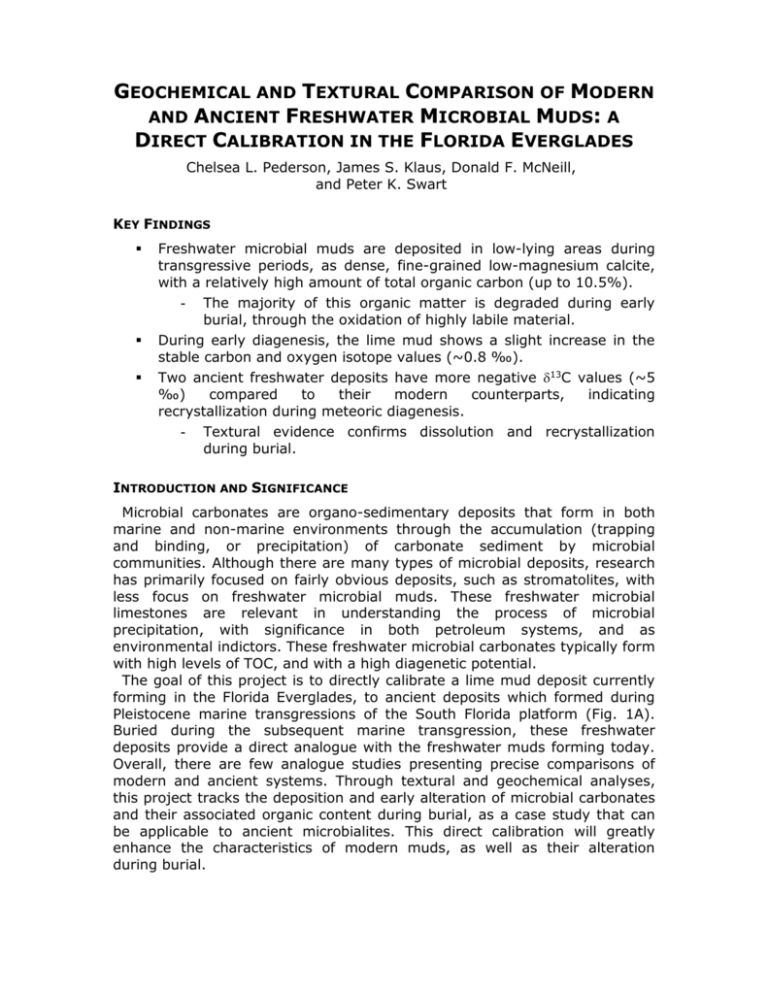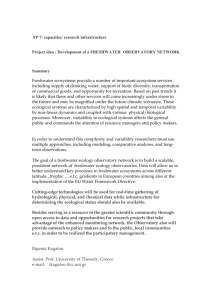Abstract link - CHELSEA PEDERSON
advertisement

GEOCHEMICAL AND TEXTURAL COMPARISON OF MODERN AND ANCIENT FRESHWATER MICROBIAL MUDS: A DIRECT CALIBRATION IN THE FLORIDA EVERGLADES Chelsea L. Pederson, James S. Klaus, Donald F. McNeill, and Peter K. Swart KEY FINDINGS Freshwater microbial muds are deposited in low-lying areas during transgressive periods, as dense, fine-grained low-magnesium calcite, with a relatively high amount of total organic carbon (up to 10.5%). - The majority of this organic matter is degraded during early burial, through the oxidation of highly labile material. During early diagenesis, the lime mud shows a slight increase in the stable carbon and oxygen isotope values (~0.8 ‰). Two ancient freshwater deposits have more negative 13C values (~5 ‰) compared to their modern counterparts, indicating recrystallization during meteoric diagenesis. - Textural evidence confirms dissolution and recrystallization during burial. INTRODUCTION AND SIGNIFICANCE Microbial carbonates are organo-sedimentary deposits that form in both marine and non-marine environments through the accumulation (trapping and binding, or precipitation) of carbonate sediment by microbial communities. Although there are many types of microbial deposits, research has primarily focused on fairly obvious deposits, such as stromatolites, with less focus on freshwater microbial muds. These freshwater microbial limestones are relevant in understanding the process of microbial precipitation, with significance in both petroleum systems, and as environmental indictors. These freshwater microbial carbonates typically form with high levels of TOC, and with a high diagenetic potential. The goal of this project is to directly calibrate a lime mud deposit currently forming in the Florida Everglades, to ancient deposits which formed during Pleistocene marine transgressions of the South Florida platform (Fig. 1A). Buried during the subsequent marine transgression, these freshwater deposits provide a direct analogue with the freshwater muds forming today. Overall, there are few analogue studies presenting precise comparisons of modern and ancient systems. Through textural and geochemical analyses, this project tracks the deposition and early alteration of microbial carbonates and their associated organic content during burial, as a case study that can be applicable to ancient microbialites. This direct calibration will greatly enhance the characteristics of modern muds, as well as their alteration during burial. Figure 1. A) Generalized cross-section of the Pleistocene and Holocene freshwater microbial carbonates. Paurotis Pond and Joe Ree rock reef form inland of the transition zone. B) Map of modern system (Paurotis Pond) and location of Pleistocene core Joe Ree Rock Reef. C) Photo of Paurotis Pond: site of modern microbial mud formation. COMPARISON OF MODERN AND ANCIENT MICROBIAL CARBONATES Modern Microbial Muds at Paurotis Pond: Everglades National Park, Florida In the modern, fine-grained low-Mg calcite (LMC) crystals (1-5 m) are precipitated and buried on a low-lying coastal plain (Fig. 1B & 1C). Photosynthetic cyanobacteria (primarily Schizothrix and Scytonema sp.) alter their microenvironment, resulting in the release of bicarbonate, and the precipitation of carbonate sediment (Merz, 1992). During a period of standing water at the site of modern microbial precipitation, we measured TOC, mineralogy, inorganic stable isotopes, organic isotopes, and elemental ICP, to provide a detailed geochemical characterization of the deposition and early diagenesis of the freshwater muds. Stable isotopic values of the precipitated muds range from 18O -1.5 to -2.5 ‰ and 13C 0.5 to -0.5 ‰, showing slight (~0.8 ‰) increases with depth (Fig. 2A). This change is attributed to one of two things: 1) the dissolved inorganic carbonate (DIC) of the formation waters have become more negative during the Holocene, or 2) waters from the Pleistocene (underlying bedrock) are diffusing up and mixing with the freshwater, where their influence increases with depth, creating heavier values from dissolved Figure 2. A) Paurotis Pond inorganic isotope values vs. depth. B) Paurotis Pond TOC and δ13Corg data. Pleistocene rock at the base of the core. Opposite to stable isotopic trends, TOC is depleted with depth from 10.4 to 4.2% as a result of the degradation of bio-available organic matter, including highly labile cyanobacterial products (extracellular polymeric substances, EPS) (Kang and Zhu, 2013). Although some degradation of organics is expected during burial, the depletion observed in the corresponding 13Corg values is generally unexpected. Typically, depletion of TOC is accompanied by an increase in 13Corg. However, research (Lehmann et al., 2002) has shown that 13Corg trends depend on both the type of organics that are being degraded, as well as the process of degradation. At Paurotis Pond, the depletion (from -23 ‰ and to -26 ‰) is likely due to the breakdown of labile material (bio-available carbohydrates and proteins), which is characteristically heavier in 13Corg values (Fig. 2B). The oxidation of this material would cause a corresponding depletion of the resulting pool of organics. This is plausible due to the role of EPS as the major food source for soil microbes (under oxic conditions). Ancient (Pleistocene) Microbial Muds: Everglades National Park, Florida Core borings of Pleistocene deposits about 20 kilometers north of Paurotis Pond penetrated three marine deposits, separated by subaerial exposures and freshwater limestones (Fig. 1B & 3C). The Pleistocene freshwater units closely resemble the modern muds at Paurotis Pond, displaying wellcemented mudstone textures and characteristic freshwater gastropod fossils. Assuming these Pleistocene deposits formed under conditions similar to the Figure 3. A) Joe Ree Rock Reef (JR) Pleistocene stable isotope data. B) JR δ13Corg data. C) JR stratigraphic column. Grey shaded areas indicate freshwater microbial mud deposits. modern muds, these buried deposits provide another step in assessing the preservation potential of the original microbial, geochemical, and textural signatures. These freshwater units are generally deposited on top of a paleosoil horizon, indicating that they formed during transgressive periods, similar to the modern (Fig. 3C). Because these freshwater units track the relative shoreline, they are useful indicators for sea-level reconstruction. Stable isotopic values of the Pleistocene freshwater muds range from 18O of -2.0 to -3.0‰, and 13C of -1.5 to -6.5‰ (Fig. 3A). These values are depleted by up to 6 ‰ relative to their modern equivalent at Paurotis Pond (18O -1.5 to -2.5‰ and 13C 0.5 to -0.5‰) (Fig. 2A). Pleistocene freshwater units at 5.2-6.6 m and 8.5-9.7 m depth (Joe Ree Rock Reef core 3) display 13C excursions relative to the adjacent marine units (Fig. 3A). Although originally LMC in mineralogy (like their modern counterpart), depletion of the original inorganic isotopic signature is likely due to meteoric cementation, dissolution of mollusc shells, and the recrystallization of the LMC material. Alteration of both marine and freshwater units has resulted in 13C values 4-6‰ lighter than the interpreted depositional signatures. Organics in the Pleistocene are also characterized by isotopic depletions from their interpreted original values. At each of the Pleistocene freshwater carbonate units, TOC (not shown) was depleted to less than 0.1%. Assuming original 13Corg signals were comparable to modern Paurotis Pond values, the trends for Pleistocene freshwater units have become more positive by up to 9‰ following burial (Fig. 3B). These positive values are interpreted to be a combination of effects; including marine organics, as well as the depletion of non-labile organic material, typically lighter in 13Corg. These data are significant because they suggest that low-energy paludal deposits are unlikely to display preservation of organic material, or original 13Corg signals, post burial. IMPLICATIONS FOR PRESERVATION OF MICROBIAL SIGNATURES Preliminary results of this study imply that organic matter produced in freshwater microbial carbonate coastal plain settings is not well preserved. Deviation from original inorganic isotope values implies that the alteration process is pervasive during subaerial exposure, as it affects even these dense LMC muds. Organic matter also displays altered signatures. However, these components may still provide some evidence of a microbial origin, as the remaining 13Corg values are typically more negative than non-microbial organics in these carbonate muds. As more labile material is often associated with microbial mats, where carbonate tends to precipitate, the selective degradation of this organic material may also have an impact on the resultant organic and inorganic isotope record in these deposits. REFERENCES Hickey, T.D., Hine, A.C., Shinn, E.A., Kruse, S.E., and Poore, R.Z., 2010, Pleistocene carbonate stratigraphy of south Florida: evidence for high-frequency sea-level cyclicity: Journal of Coastal Research, v. 1, p. 605-614. Merz, M.U., 1992, Biology of carbonate precipitation by cyanobacteria: Facies, v. 26, p. 81101.





